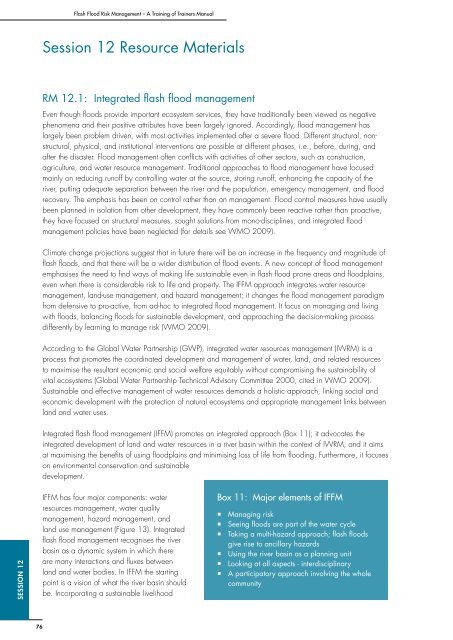Flash Flood Risk Management â A Training of Trainers ... - ReliefWeb
Flash Flood Risk Management â A Training of Trainers ... - ReliefWeb
Flash Flood Risk Management â A Training of Trainers ... - ReliefWeb
You also want an ePaper? Increase the reach of your titles
YUMPU automatically turns print PDFs into web optimized ePapers that Google loves.
<strong>Flash</strong> <strong>Flood</strong> <strong>Risk</strong> <strong>Management</strong> – A <strong>Training</strong> <strong>of</strong> <strong>Trainers</strong> Manual<br />
Session 12 Resource Materials<br />
RM 12.1: Integrated flash flood management<br />
Even though floods provide important ecosystem services, they have traditionally been viewed as negative<br />
phenomena and their positive attributes have been largely ignored. Accordingly, flood management has<br />
largely been problem driven, with most activities implemented after a severe flood. Different structural, nonstructural,<br />
physical, and institutional interventions are possible at different phases, i.e., before, during, and<br />
after the disaster. <strong>Flood</strong> management <strong>of</strong>ten conflicts with activities <strong>of</strong> other sectors, such as construction,<br />
agriculture, and water resource management. Traditional approaches to flood management have focused<br />
mainly on reducing run<strong>of</strong>f by controlling water at the source, storing run<strong>of</strong>f, enhancing the capacity <strong>of</strong> the<br />
river, putting adequate separation between the river and the population, emergency management, and flood<br />
recovery. The emphasis has been on control rather than on management. <strong>Flood</strong> control measures have usually<br />
been planned in isolation from other development, they have commonly been reactive rather than proactive,<br />
they have focused on structural measures, sought solutions from mono-disciplines, and integrated flood<br />
management policies have been neglected (for details see WMO 2009).<br />
Climate change projections suggest that in future there will be an increase in the frequency and magnitude <strong>of</strong><br />
flash floods, and that there will be a wider distribution <strong>of</strong> flood events. A new concept <strong>of</strong> flood management<br />
emphasises the need to find ways <strong>of</strong> making life sustainable even in flash flood prone areas and floodplains,<br />
even when there is considerable risk to life and property. The IFFM approach integrates water resource<br />
management, land-use management, and hazard management; it changes the flood management paradigm<br />
from defensive to pro-active, from ad-hoc to integrated flood management. It focus on managing and living<br />
with floods, balancing floods for sustainable development, and approaching the decision-making process<br />
differently by learning to manage risk (WMO 2009).<br />
According to the Global Water Partnership (GWP), integrated water resources management (IWRM) is a<br />
process that promotes the coordinated development and management <strong>of</strong> water, land, and related resources<br />
to maximise the resultant economic and social welfare equitably without compromising the sustainability <strong>of</strong><br />
vital ecosystems (Global Water Partnership Technical Advisory Committee 2000, cited in WMO 2009).<br />
Sustainable and effective management <strong>of</strong> water resources demands a holistic approach, linking social and<br />
economic development with the protection <strong>of</strong> natural ecosystems and appropriate management links between<br />
land and water uses.<br />
Integrated flash flood management (IFFM) promotes an integrated approach (Box 11); it advocates the<br />
integrated development <strong>of</strong> land and water resources in a river basin within the context <strong>of</strong> IWRM, and it aims<br />
at maximising the benefits <strong>of</strong> using floodplains and minimising loss <strong>of</strong> life from flooding. Furthermore, it focuses<br />
on environmental conservation and sustainable<br />
development.<br />
session 12<br />
IFFM has four major components: water<br />
resources management, water quality<br />
management, hazard management, and<br />
land use management (Figure 13). Integrated<br />
flash flood management recognises the river<br />
basin as a dynamic system in which there<br />
are many interactions and fluxes between<br />
land and water bodies. In IFFM the starting<br />
point is a vision <strong>of</strong> what the river basin should<br />
be. Incorporating a sustainable livelihood<br />
Box 11: Major elements <strong>of</strong> IFFM<br />
• Managing risk<br />
• Seeing floods are part <strong>of</strong> the water cycle<br />
• Taking a multi-hazard approach; flash floods<br />
give rise to ancillary hazards<br />
• Using the river basin as a planning unit<br />
• Looking at all aspects - interdisciplinary<br />
• A participatory approach involving the whole<br />
community<br />
76

















